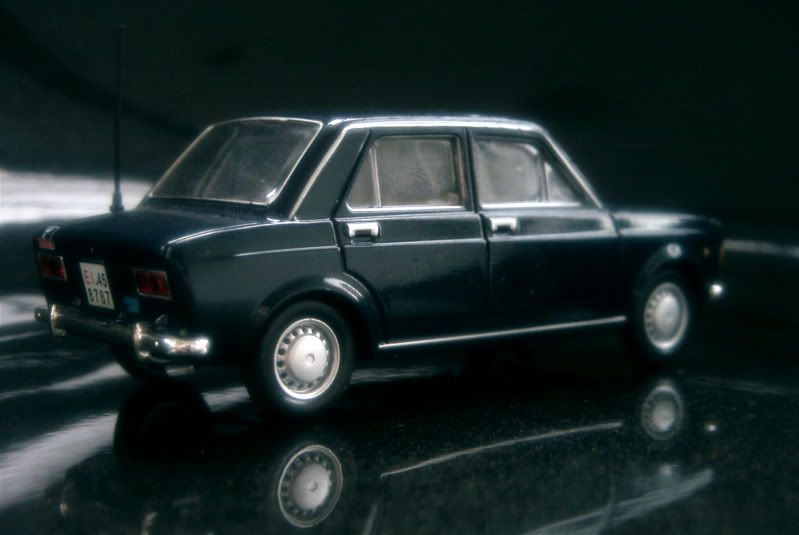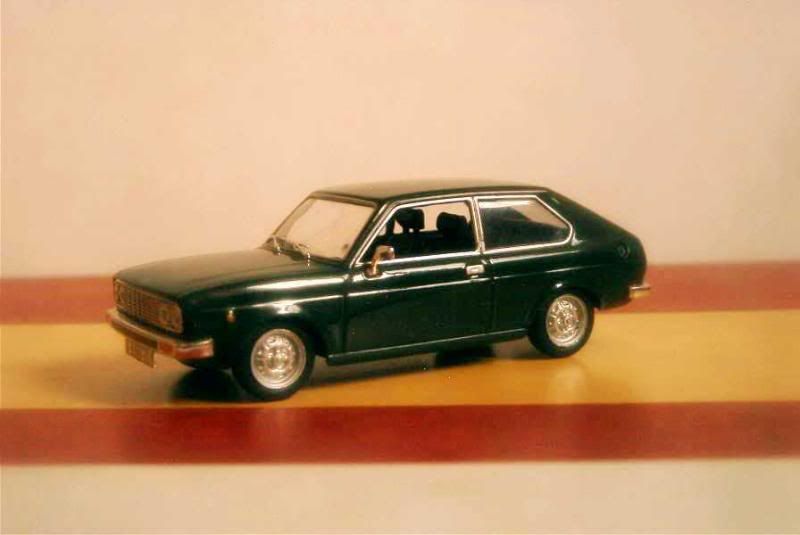A little history
By 1969, the Fiat 1100 was a dated automobile, tracing its ancestry back to 1953, and even as far back as 1937 for its engine. The car was still successful in its native Italy, but the gradual opening of foreign markets to competition meant Fiat needed a much modern offer. In its 128 model, the company found just that.
The conventional layout of the 1100 was forgotten, and replaced by bold solutions. The 128’s engine, a brand new SOHC 1.1-litre four largely employing light alloys for its construction, was placed transversally and drove the front wheels. The gearbox could be squeezed into the front compartment thanks to the use of unequal-length drive shafts, shortening the bonnet and allowing for a roomier passenger compartment. With its four wheels pushed to each corner, its rather low centre of gravity and its peppy engine, the 128 was a joy to drive. And should you need to stop, it had brakes to match.
Fiat’s package was so good that it’s almost no surprise that the 128 received the European Car of the Year award in 1970. Sales were skyrocketing, not only on the home market but also abroad. Though the 128 proved not immune to the quality concerns encountered by all Italian cars of the era, its buyers still were amply satisfied with their purchase. Initially offered from March 1969 in three body types (two- and four-door saloons, two-door estate), the 128 range was joined by new models over time. In 1971, a 1.3-litre “Rally” was introduced, along with a splendid fastback coupe as only Italians seem able to make. Three years later, the “Special” introduced the Rally engine to a less sporty range. In 1975, the original coupe was replaced by the “Berlinetta”, again featuring a body unrelated to the saloon, which was roughly similar to its predecessor but had a more squarish look and a practical hatchback. In the meantime, part of the 128’s drivetrain had been borrowed by the radical X1/9 coupe.
The introduction of the Ritmo in 1978 didn’t bring the 128’s retirement, but meant nonetheless that the car now had a competitor from within. The 128 was kept in Fiat’s range as a cheaper alternative to the Ritmo, retaining only the 1.1-litre engine from 1979. Sales of the old car were helped by the controversial styling of its successor, which led many customers to stick to the then-conventional design of the 128. To satisfy such a demand, the car was built until 1985, bringing the final production count to 3.1 millions.
In addition to the 128s built in Italy, and to those assembled by the many foreign plants belonging to Fiat, Spanish company Seat offered both the saloon and the coupe, while Zastava from Yugoslavia not only produced the saloon and the estate, but also added a locally-designed hatchback saloon that enjoyed a lasting success in the whole of Europe. Revamped and renamed Skala, the Zastava version of the 128 is still built today, forty years after the original car has been introduced.
About the models
Model: Fiat 128
Year: c.1972
Maker: Grani & Partners
Scale: 1/43
Distributed by: De Agostini as no.15 of its Carabinieri press series
Acquired: second hand with neither box nor stand, offered by a friend and fellow collector in August 2008, in Manila, Philippines
This model is surprisingly good for a press series release: it is perfectly proportioned, detailed and nicely decorated. In my opinion, well worth 14/20.


Model: Seat 128
Year: 1977
Maker: Ixo
Scale: 1/43
Distributed by: Altaya as no.37 of its Nuestros Queridos Coches press series
Acquired: new with neither box nor stand (probably a production overrun or quality control reject), in December 2006, in Hong Kong, S.A.R.
Altaya’s Spanish collection of classic road cars logically included many Seat models. This provided Ixo with an excuse to produce this elegant Seat 128 coupe, the equivalent of the Italian Fiat 128 Berlinetta. Nothing particularly graceful about the dark green paint, but this model’s quality is nonetheless undeniable: 13/20.



By 1969, the Fiat 1100 was a dated automobile, tracing its ancestry back to 1953, and even as far back as 1937 for its engine. The car was still successful in its native Italy, but the gradual opening of foreign markets to competition meant Fiat needed a much modern offer. In its 128 model, the company found just that.
The conventional layout of the 1100 was forgotten, and replaced by bold solutions. The 128’s engine, a brand new SOHC 1.1-litre four largely employing light alloys for its construction, was placed transversally and drove the front wheels. The gearbox could be squeezed into the front compartment thanks to the use of unequal-length drive shafts, shortening the bonnet and allowing for a roomier passenger compartment. With its four wheels pushed to each corner, its rather low centre of gravity and its peppy engine, the 128 was a joy to drive. And should you need to stop, it had brakes to match.
Fiat’s package was so good that it’s almost no surprise that the 128 received the European Car of the Year award in 1970. Sales were skyrocketing, not only on the home market but also abroad. Though the 128 proved not immune to the quality concerns encountered by all Italian cars of the era, its buyers still were amply satisfied with their purchase. Initially offered from March 1969 in three body types (two- and four-door saloons, two-door estate), the 128 range was joined by new models over time. In 1971, a 1.3-litre “Rally” was introduced, along with a splendid fastback coupe as only Italians seem able to make. Three years later, the “Special” introduced the Rally engine to a less sporty range. In 1975, the original coupe was replaced by the “Berlinetta”, again featuring a body unrelated to the saloon, which was roughly similar to its predecessor but had a more squarish look and a practical hatchback. In the meantime, part of the 128’s drivetrain had been borrowed by the radical X1/9 coupe.
The introduction of the Ritmo in 1978 didn’t bring the 128’s retirement, but meant nonetheless that the car now had a competitor from within. The 128 was kept in Fiat’s range as a cheaper alternative to the Ritmo, retaining only the 1.1-litre engine from 1979. Sales of the old car were helped by the controversial styling of its successor, which led many customers to stick to the then-conventional design of the 128. To satisfy such a demand, the car was built until 1985, bringing the final production count to 3.1 millions.
In addition to the 128s built in Italy, and to those assembled by the many foreign plants belonging to Fiat, Spanish company Seat offered both the saloon and the coupe, while Zastava from Yugoslavia not only produced the saloon and the estate, but also added a locally-designed hatchback saloon that enjoyed a lasting success in the whole of Europe. Revamped and renamed Skala, the Zastava version of the 128 is still built today, forty years after the original car has been introduced.
About the models
Model: Fiat 128
Year: c.1972
Maker: Grani & Partners
Scale: 1/43
Distributed by: De Agostini as no.15 of its Carabinieri press series
Acquired: second hand with neither box nor stand, offered by a friend and fellow collector in August 2008, in Manila, Philippines
This model is surprisingly good for a press series release: it is perfectly proportioned, detailed and nicely decorated. In my opinion, well worth 14/20.


Model: Seat 128
Year: 1977
Maker: Ixo
Scale: 1/43
Distributed by: Altaya as no.37 of its Nuestros Queridos Coches press series
Acquired: new with neither box nor stand (probably a production overrun or quality control reject), in December 2006, in Hong Kong, S.A.R.
Altaya’s Spanish collection of classic road cars logically included many Seat models. This provided Ixo with an excuse to produce this elegant Seat 128 coupe, the equivalent of the Italian Fiat 128 Berlinetta. Nothing particularly graceful about the dark green paint, but this model’s quality is nonetheless undeniable: 13/20.






No comments:
Post a Comment